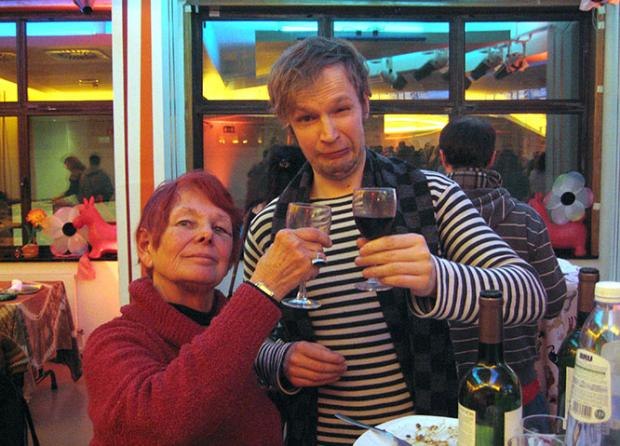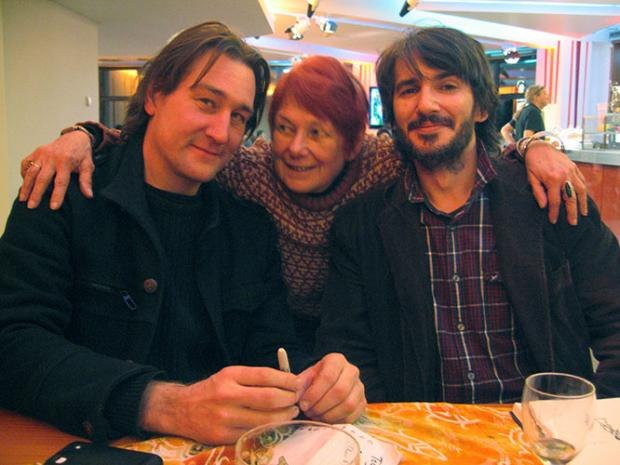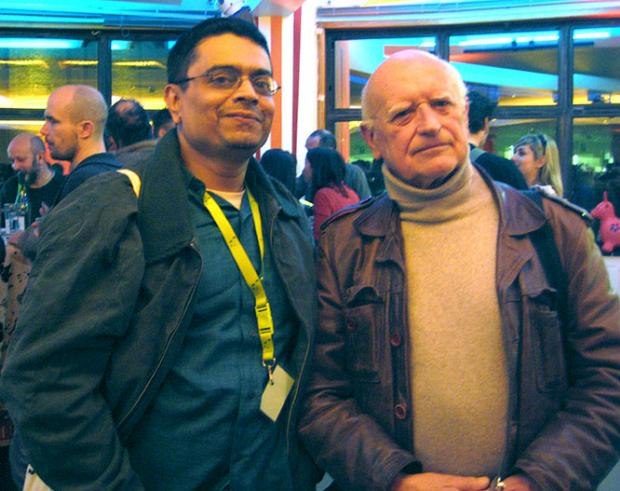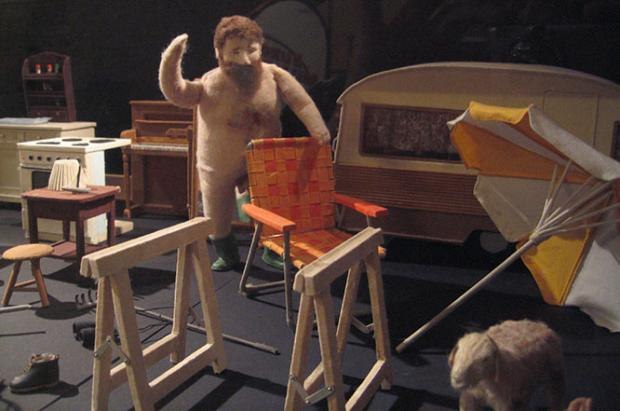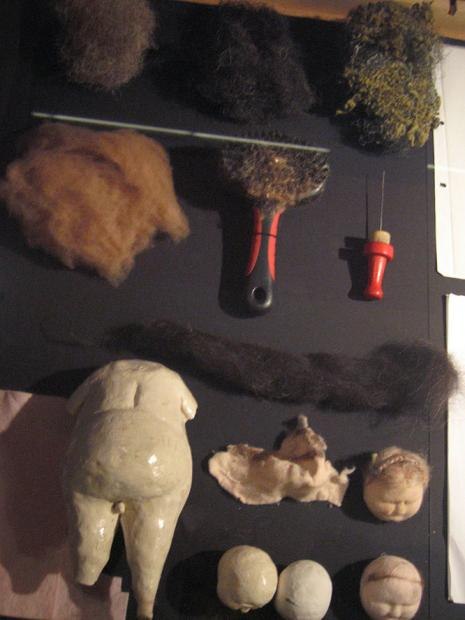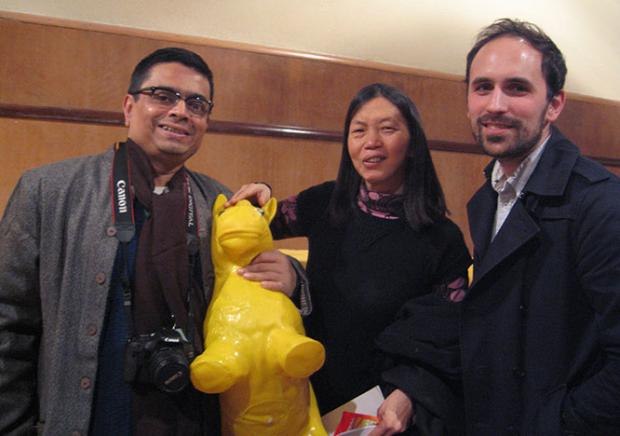Each year I look forward to Anima Brussels because it is my first festival of the year and an opportunity to see a large number of new Belgian animated films. Over the ten days of ANIMA there are also many noted guests and old friends.
By Nancy Phelps
Each year I look forward to Anima Brussels because it is my first festival of the year and an opportunity to see a large number of new Belgian animated films. Over the ten days of ANIMA there are also many noted guests and old friends.
The festivities got off to a start opening night with the much anticipated Italian/Belgian/Luxemburg animated feature co-production Pinocchio by Italian director Enzo D’Alo.
The first half of the animated feature seemed to drag along slowly, it comes to life in the second half, when Pinocchio reaches Donkey Island. Suddenly the screen lit up with characters that looked straight out of the American/German artist Richard Lindner’s paintings, bursting into song and dance as the wayward boys get lured into the dungeon where they are slowly turned into donkeys. Lorenzo Mattotti’s brilliant talents as a noted comic book artist and graphic designer are shown to their fullest in this sequence.
Unfortunately this was an all too short interlude. The sequence of Gepetto and Pinocchio in the belly of the whale lacked the beauty and poetry of the Disney classic and seemed to go on too long. On a positive note, this film adhered very closely to Carlo Collodri’ 1890’s The Adventures of Pinocchio, but for sheer magic and visual beauty this version falls short of Disney’s 1940 classic.
One of the special features of ANIMA is the three This Is Belgium screenings which showcase what’s new in Belgian animation. In the last couple of years I have done voiceover work on several Belgian films, but I only see the sections of the films that I am working on. Last fall I did some work on director Remi Vandenitte’s Betty’s Blues and it was really nice to see the film on the big screen.
Vandenitte showed a real understanding of the Southern United States and segregation in his portrayal of New Orleans in the 1920’s. The story of a young black musician and his girlfriend who are attacked by the KKK is deftly told in song. The musician is blinded and his girlfriend killed in the encounter, but from the horror of the attack the musician learns the power his music has to move everyone regardless of the colour of their skin.
The Belgian jury seemed impressed by the 2D/puppet animation film because they awarded it the RTBF –LaTrois Award, which insures the purchase of broadcast rights for Betty’s Blues. The film was also awarded a Special Mention as the Best Belgian Student Short Film.
I first saw One for the Road (Eentje voor Onderweg) at a preview screening several months ago and I thought that it was very humorous. Watching director Lander Ceuppens’ tale of a broken hearted fellow who tries to commit suicide without any success because the grim reaper doesn’t arrive on time made me laugh just as much at the second viewing.
The simple line drawings and minimal use of color lends itself perfectly to the story of the unlikely duo’s all night drinking bout and the climax of the film when the man and the reaper both sober up the next morning.
It was obvious that Oh Willy, Emma de Swaef and Marc Roels’ amazing puppet animation, was the best film in the Belgian Competition. The film has won numerous awards at festivals worldwide including the prestigious Cartoon d’ Or. Unfortunately the top Belgian award at ANIMA, Le Grand Prix de la Federation Wallonie-Brussels is sponsored by the French (Wallonie) speaking half of Belgium and as a result only films made by French speaking Belgians are eligible. Oh Willy was awarded the SACD (a Belgian author’s rights organization) Award.
For anyone not familiar with Belgian politics, I’m afraid that I cannot quickly explain the situation here. There have been countless articles written about the complicated situation and there is still no solution in site. I do hope that in the future some Flemish organization will step forward and give an award so there can be two separate but equal Best Belgian films.
Deux Iles (Two Islands) walked off with not only the Wallonie Grand Prix but the Best Belgian Student Short as well. The five minute film was the co-operative work of eight students for Laboratories Images and produced by Cargo Film and Canal+.
The Laboratories Images challenge was for the group to bring the work of an illustrator to life. They selected the well known author and Belgian comic illustrator Eric Lambe. All of Lambe’s illustrations are created from frames of blue and black overlapping pen drawings. The catalogue synopsis says “In a curious field of blue ink, vibrant scratches, and electric opacity, two people meet, intersect, bind, untie, merge, and intermingle without ever meeting”. That is as clear a description as I can give.
I had already seen and written about most of the short films in competition that I considered top notch but there are always new treats to see and a few films that I had not paid enough attention to before. A new delight for me was Russian animator Sonya Kendel’s graduation film from Moscow’s School-Studio “Shar”. Pishto uyeszhayet (Pishto Goes Away) is a tale of Pishto, the cat, who becomes fed up with his life and sets off to discover a better world. Before he can go very far he meets an adorable puppy who is lonely and suddenly everything changes for Pishto. The simple line drawings in muted shades of brown and grey lend themselves perfectly to the story and I can see Pishto as the “hero” of a series of adventures.
I am sure that I have seen Night of the Loving Dead before, but this time Anna Humphries’ quirky zombie silhouette animation caught my eye. Anna’s graduation film from the UK National Film and Television School is the story of a love sick teenager who lives with his wicked sex-obsessed step mother. When he accidently brings his dead girlfriend back to life he gets much more than he bargained for. Anna told me that she has always been fascinated by silhouette animation and made this film as a tongue in cheek homage to the great pioneer of this style, Lotte Reiniger.
I have seen Feral several times and I have always been left with an unsettled feeling. The combination of 2-D graphically animated characters and hand painted frames gives Daniel Sousa’s film a dark, brooding quality that adds to the eerie tale of a wild boy found in the woods by a hunter. The story is based on historical accounts of children who have been abandoned and the attempts to re-introduce them into society. American animator Sousa blends mythology, fairy tales, and reality to portray the usually disastrous results of these attempts. The jury was also intrigued by the film and awarded the Grand Prix to Feral.
Feature films have to be really good to hold my interest for an hour and a half to two hours. Far too often I find myself thinking “How much longer until this is over?” but ANIMA Brussels had several full length films that I thoroughly enjoyed.
Unlike so many animated features, the Northern Spanish 3-D stop motion El Apostal (The Apostal) is definitely an adult film. Based on a story rooted in folklore, tradition, and Northern Spanish history, director Fernando Cortizo weaves terror, humor, and fantasy to tell a tale that held my interest until the very end. The film’s main theme composed by Phillip Glass sets a perfect tone for the story of an escaped convict who returns to a remote village to retrieve his loot. What should be a simple thing to do turns into a real life nightmare for the convict, involving a strange priest, wandering spirits, and odd disappearances. El Apostal is slated for commercial release in Spain, Latin and South America, but unfortunately so far there is no US distributor which doesn’t surprise me since there seems to be almost no market for intelligent adult oriented animation there.
I was totally charmed by Mamoru Hosoda’s Okami Kodomo no Ame to Yuki (Ame and Yuki, Wolf Children). The Japanese animator weaves fantasy and realistic settings to tell the story of the two children, Ame and Yuki, and their mother, Hana. The three of them live a simple, happy life in a quiet corner of a big city until it becomes harder and harder to conceal the dark family secret that their dead father was a werewolf. Hana and her children move to the countryside by a beautiful forest where the children are free to express both sides of their true nature.
Wolf Childen is a film that can be enjoyed by children and adults alike with a lovely message for both. Children should not be forced to conform to their elders’ expectations, and parents must allow their children to be who they really are and give them wings to fly free.
Although not as visually lovely as Wolf Children, Momo E No Tegami (A Letter to Momo) by Hiroyuki Okiura also blends fantasy and reality. The film centers on eleven year old Momo who is finding it difficult to cope with all of the sudden changes in her life following her beloved father’s death. Momo and her mother go to live at her mother’s childhood home on a remote island where she finds it difficult to fit in.
Momo’s father had left her a letter with only two words “Dear Momo” written on it. She struggles to understand what her father wanted to say to her and to make her mother believe that she is hearing strange sounds coming from the attic. When Momo finally meets three imps in the attic, she discovers that her father’s two word letter is connected to her arrival on the islands and the strange events that began to occur there.
Because ANIMA Brussels takes place during Belgium’s Carnival school holiday, mornings and afternoons were devoted to programs for younger audiences. New episodes of the very popular Spanish series The Adventures of Capelito had the the audience of three and four year olds laughing gleefully. The eight new stop-motion animations about a little mushroom named Capelito with a magic hat once again finds him getting into all sorts of silly situations as he tries to catch fish, woo his lady friend, and go on a visit to a tropical rain forest. The forty minute program was the perfect way for parents to introduce small children to their first cinema adventure.
There were numerous short film programs for young people of all ages. My favorite was a selection of four short beautifully animated tales from Russia’s renowned Pilot Studio. The films were created by some of the greatest names in Russian animation such as the late, grate guiding light of Pilot Alexander Tatarsky’s Le Rossignol, Histoires d’ours by Mikhail Aldashin, Zhiharka from Oleg Uzhinov, and Eduard Nazarov and Marina Karpova’s Le Maison des biquettes. I had seen all four of the films before but they were just as charming and captivating as the first time that I saw them.
There were also numerous feature films for young people of all ages and it was very encouraging to see that the morning and afternoon programs were well attended. My favourite feature for young audiences, The Day of the Crows, turned out to be a very pleasant surprise for me because I hadn’t expected to really enjoy it.
The hand drawn film is based on a novel by Canadian writer Jean-Francois Beauchemin and directed by French director Jean-Christophe Dessaint. The story revolves around a boy growing up deep in the forest with his father where they lead a tough, wild life with only the forest ghosts as companions. The boy’s accidental discovery of love in an unexpected place leads him on a search for why his gruff father is hiding his love for his son.
From the moment the opening credits appeared I was captivated by the beautiful forest ghosts and backgrounds, but the character design of the father and especially the son just didn’t seem to fit the overall design of the film. As the plot unfolded and I began to understand the complexities of the story the forms of the two main characters slowly began to make perfect sense. The film moves at a leisurely pace but when all is revealed at the end it turns out to be an excellent story with characters that I cared about.
Young people also had the opportunity to learn about animation at a hands on level at the stop-motion workshop put together by Zorobabel and Kidscam. Every time I visited it the room was alive with small groups moving objects and filming them to create their own short animations.
Each evening the festival café staff prepared delicious meals for the festival guests. Often at festivals everyone is so busy that it is hard to find time for informal chats so dinner proved the perfect opportunity to meet everyone in one place. The highlight of the ten day festival for me was the two long dinners I enjoyed with animation legend Børge Ring, his wife, daughter and son-in-law. I had become a friend of Børge’s delightful daughter Anne-Mieke Bovelett-Ring at Annecy in 2012 where she introduced a retrospective of her father’s work. You can read a full account of that screening in my July 2012 Annecy article at:
http://sprockets.animationblogspot.com/
Børge and his wife Janikawho live in Overiangel in the Netherlands seldom travel to animationfestivals so their visit to ANIMA was a real treat for me. Janika, whois a sculptor and writer, showed me pictures of their thatched roof homewhich was tragically destroyed by fire in February of last year. Shetold me that they plan to rebuild their home on the same site exactly as itwas. It’s sad to think of all of the treasures that were lost in thedisaster, including Børge’s Oscar which he received in 1984 for Anna andBella, but he has already started collecting new awards to decorate theirhome, beginning with the 2012 Winsor McCay Award presented to him andaccepted by his daughter at the 2012 Annie Awards for his outstanding lifelong contribution to animation.
Børge, who is 92 years young, may not move as fast as he once did but his mind is as sharp as a tack and the mischievous twinkle in his eyes and quick wit have not aged a bit. I thoroughly enjoyed listening to his wonderful stories.
My Czech friend Michaela Pavlatova is not only a brilliant animator but an entertaining speaker. She gave one of the most insteresting master classes that I have attended in a long time. Instead of primarily talking about her own work she showed examples of films that have inspired her and how they have influenced her own approach to animation. It was a rare opportunity to get a peak into how a very creative mind developed into a top notch animator. In 1993 Michaela’s film Words, Words, Words was nominated for an Academy Award and her current film Tram has been garnering awards at festivals world wide. In 2012 Tram took home the coveted Annecy Crystal and was short listed for an Oscar this year.
ANIMA Brussels is such a wonderful festival because of the quality of the screenings but even better, each year it gives me an opportunity to informally meet the top names in the animation world. I have seen French animator Franck Dion’s Edmond Was a Donkey several times and the tale about an office worker who refuses to be like everyone else and slowly discovers his true nature never fails to touch me. I finally had the opportunity to meet Franck at the festival party for all of the guests and he is as delightful as his film.
It was good to talk to Raoul Servais at the party also. As well as creating such critically acclaimed work as Taxandria and Harpya which won the Palme d’ Or for Best Short Film at the Cannes Film Festival he is the founder of the first European department of animation, KASK, as part of the Academie at what is now Hogeschool Gent (University College) in Gent, Belgium in 1966. At 82 Raoul is still quite charming and still takes an active interest in the animation community, attending festivals and the yearly film finals at KASK.
I was delighted to see my friend Sekhar Mukherjee from India who was on the International Competition Jury. Sekhar is a comic book artist, illustrator, graphic designer, animator and he supervises the animation department of the National Institute of Design (NID) in Ahmedabad, India. Most of the Indian animation that I have seen has not been very good, with poor animation and content. Sekhar told me that most of the animation created in India is for outsourcing, especially for American studios, which has greatly influenced what students are taught in animation schools. A few schools such as NID are fighting hard to create original, locally based film. His impressive Indian Animation Today screening provided a good overview of the creative work that is being done not just in some schools but also by independent animators in such areas as commercials, ethnic, and satirical animation.
Journey to Nagaland which took Aditi Chitre two and a half years to complete is a beautifully drawn animation that tells a personal story. The film is about a young girl from Bombay who is haunted by the ghost of a woman in a red shawl. Searching for her families’ roots she is guided by an eagle, carrier of the dead woman’s spirit, to Nagaland where the mystery of the apparition is revealed to her. Woven into the story are Naga folk songs, customs, and beliefs which have continued even after the tribe adopted Christianity.
Nagaland is in the remote mountainous North-Eastern corner of India. The natives were known as the fiercest headhunters in the world and Sekhar told me that it is difficult even for Indian residents to visit there.
A very important part of Anima is the annual Pecha Kucha project pitching session. Pecha Kucha literally means blah-blah in Japan where the concept originated. The thirteen participates were allowed twenty slides each which were projected on the big screen for twenty seconds each while the participant talks about their project. I find Pecha Kucha a good opportunity to get an advance look at what might just be the next hit film.
I have seen Oh Willy countless times but The Magic of Stop-Motion Animation exhibition gave me my first opportunity to see the actual beautifully crafted puppets firsthand. The puppets and sets, down to the smallest detail like the toilet seat, were meticulously created out of felt. In honor of the recent Belgian/Luxemburg stop-motion films Par les fenetres (Through the Windows) by Christophe Gautry and Arnaud Demuynck, Olivier Pesch’s Emille, and the Cartoon d’Or winning Oh Willy by Emma De Swaef and Marc Roels the extensive exhibition gave film fans a behind the scenes glimpse at how puppets are constructed and brought to life. The Behind the Scenes of Stop Motion session gave the audience a chance to hear film makers analyse their films from the actual creation of the puppets to building the sets, compositing and special effects.
Animated Night is exactly what it says. From 9:30 PM until about 3 AM the main screening room of the Flagey brightened the long, cold winter night with 50 short films, music videos, and commercials. The selection ranged from the sublime to films so bad that they were good silly fun to watch. Every couple of hours there was a break to visit the bar and listen to music by DJ The Wild and The Wild Boar and Bull Brass Band.
After each session the audience could vote for their favourite film. My favourite of the evening was Oh Sheep! Gottfried Mentor’s diploma film at the Filmacademy Baden-Wuerttemberg in Ludwigsburg, Germany. His tale of two flocks of lonely sheep looking for companionship and their two feuding shepherds who try to keep them apart with dire consequences is equally part tragedy and humor. The rest of the audience agreed with me and voted Oh Sheep! the Animated Nights Audience Award for Best Short Film.
I had the opportunity to talk to Gottfried about his film and he told me that his big challenge in making it was to create sheep that were original looking so that his film would not be compared to Nick Park’s very clever film Shaun the Sheep about a flock of sheep, Bouser the trusty dog, and the farmer. There were no pink hair curlers, cute baby lamb, or pesky pigs and Mentor succeeded because his sheep did have their own unique look.
Days just flew by and all too soon it was time for the closing ceremony. After the vast army of volunteers were called to the stage and their hard work acknowledged with a loud round of applause, Stephanie Coerten got down to business of the awards. A full list of the juries and awards is at the end of the article.
Once again this year festival coordinators Doris Cleven and Phillippe Moins put together wonderful competition screenings, special programs, and exciting events. I owe a warm thank you to Karin Vandenrydt and Noémie Meert who were always on hand to answer my questions and help me with anything that I needed. The numerous volunteers were always happy to go out of their way to help visitors and guests alike.
I am already looking forward the treats Anima Brussels 2014 will hold for us. You can see find out about ANIMA Brussels, see more photos and check out The Best of Anima 8 DVD on the festival web site:
INTERNATIONAL COMPETITION JURY:
Kim Keukeleire, Belgium; Sekhar Mukherjee, India; Benjamin Renner, France
NATIONAL COMPETITION JURY:
Kim Duchateau, Belgium; William Henne, Belgium; Andrea Martignoni, Italy
International Competition JURY AWARDS Grand Prix Anima 2013 offered by the Brussels-Capital Region
Feral by Daniel Sousa
Anima 2013 Award for Best Professional Short Film Palmipedarium by Jérémy Clapin
Special Mention: The People Who Never Stop by Florian Piento
Anima 2013 Award for Best Student Short Film Pripad by Martin Zivocky
Special Mention: Soeur et frère by Marie Vieillevie
Best Music Video Award
Converse “Doyathing” by Jamie Hewlett
Best Advertising Award
Russian Railways “175 years of Russian Railways” by Alexander Petrov and Dima Petrov
Anima 2013 Award for Best Children’s Short Film (Radio Bobo-jury)
The Fantastic Flying Books of Mr Morris Lessmore by William Joyce and Brandon Oldenburg
Special Mention: L’Automne de Pougne by Pierre-Luc Granjon and Antoine Lanciaux AUDIENCE AWARDS Fluxys Award for Best Short Film
Fear of Flying by Conor Finnegan
Audience Award for Best Children’s Short Film
L’Automne de Pougne by Pierre-Luc Granjon and Antoine Lanciaux
Animation Night Audience Award for Best Short Film Oh Sheep! by Gottfried Mentor
Audience Award for Best Animated Feature , sponsored by FedEx Crulic - Drumul Spre Dincolo / Crulic - The Path To Beyond by Anca Damian
Audience Award for Best Children’s Animated Feature
Tadeo Jones, El Tablero / Tad l’Explorateur. A la recherche de la cité perdue by Enrique Gato
PARTNER AWARDS BeTV Award
for Best Animated Feature Crulic - Drumul Spre Dincolo / Crulic - The Path To Beyond by Anca Damian
Format Court Award
for Best Student Short Film I am Tom Moody by Ainslie Henderson
National Competition
JURY AWARDS
Grand Prix of the Fédération Wallonie - Bruxelles
Deux Îles by Eric Lambé, Adrien Cellieres, Nicolas Debruyn, Florian Guillaume, Guillaume Franck, Sarah Heinrich, Lucile Martineau, Gilles Pirenne, Valery Vasteels
SACD Award Oh Willy… by Emma De Swaef and Marc James Roels
SABAM Award
De Wake by Pieter Coudyzer
TVPaint Award
for Best Belgian Student Short Film Deux Îles by Eric Lambé, Adrien Cellieres, Nicolas Debruyn, Florian Guillaume, Guillaume Franck, Sarah Heinrich, Lucile Martineau, Gilles Pirenne, Valery Vasteels
Special Mention : Betty’s Blues by Rémi Vandenitte
PARTNER AWARDS
BeTV Award
Maintenant il faut grandir by Bruno Tondeur
Betty’s Blues by Rémi Vandenitte
Cinergie Award
Oh Willy… by Emma De Swaef and Marc James Roels
Dan Sarto is Publisher and Editor-in-Chief of Animation World Network.
